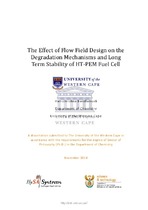| dc.contributor.advisor | Pasupathi, Sivakumar | |
| dc.contributor.advisor | Bujlo, Piotr | |
| dc.contributor.author | Bandlamudi, Vamsikrishna | |
| dc.date.accessioned | 2019-05-09T08:31:11Z | |
| dc.date.available | 2019-05-09T08:31:11Z | |
| dc.date.issued | 2018 | |
| dc.identifier.uri | http://hdl.handle.net/11394/6752 | |
| dc.description | Philosophiae Doctor - PhD | en_US |
| dc.description.abstract | Fuel cells are long term solution for global energy needs. In current fuel cell
technologies, Proton Exchange Membrane (PEM) fuel cells are known for quick start-up
and ease of operation compared to other types of fuel cells. Operating PEM fuel cells at
high temperature show promising applications for stationary combined heat and power
application (CHP). The high operating temperature up to 160°C allows waste heat to be
recovered for co-generation or tri-generation purposes. The commercially available PEM
fuel cells operating at 160⁰C can tolerate up to 3% CO without significant loss of
performance, making HT-PEM fuel cell viable choice when reformate is used. In reality
these advantages convert to very little balance-of-plant compared to Nafion® based fuel
cells operating at 60°C.
However, there are some problems that prevent high temperature fuel cells from large
scale commercialization. The cathode is said to have sluggish reaction kinetics and high
cell potentials and operating temperature during fuel cell start-up may cause severe
degradation. The formation of liquid water during the shut-down can cause the
phosphoric acid to leach from the cell during operation. Efforts are being made to
reduce the cost and increase the durability of fuel cell components (such as catalyst and
membrane) at high temperatures. Apart from degradation issues, the problems are
related to cost and performance. The performance of the PEM fuel cells depends on a
lot of factors such as fuel cell design and assembly, operating conditions and the flow
field design used on the cathode and anode plates. The flow field geometry is one
important factor influencing the performance of fuel cells. The flow fields have
significant effect on pressure and flow distribution inside the fuel cell. A homogeneous
distribution of the reactant gases over the active catalyst surface leads to improved
electrochemical reactions and thus enhances the performance of the fuel cell. So, the
design of flow fields is one of the important issues for performance improvement of
PEM fuel cell in terms of power density and efficiency. There are different types of flow
fields available for PEM fuel cells such as serpentine, pin, interdigitated and straight flow
fields but the most obvious choice is multiple serpentine. The same can be used for high
temperature PEM fuel cell (HT-PEMFC) application with ease because of absence of
liquid water during the high temperature operation and no need for complex water
management. | en_US |
| dc.language.iso | en | en_US |
| dc.publisher | University of the Western Cape | en_US |
| dc.subject | Flow feed design | en_US |
| dc.subject | Degradation mechanisms | en_US |
| dc.subject | HT-PEM fuel cell | en_US |
| dc.subject | Proton Exchange Membrane (PEM) | en_US |
| dc.title | The effect of flow field design on the degradation mechanisms and long term stability of HT-PEM fuel cell | en_US |
| dc.rights.holder | University of the Western Cape | en_US |

